Experimental and FE Investigations of Backfill Cover on Large-Diameter GRP Pipes
Abstract
1. Introduction
2. Experimental Work
2.1. Materials Descriptions
2.1.1. GRP Pipes
2.1.2. Backfill Soil
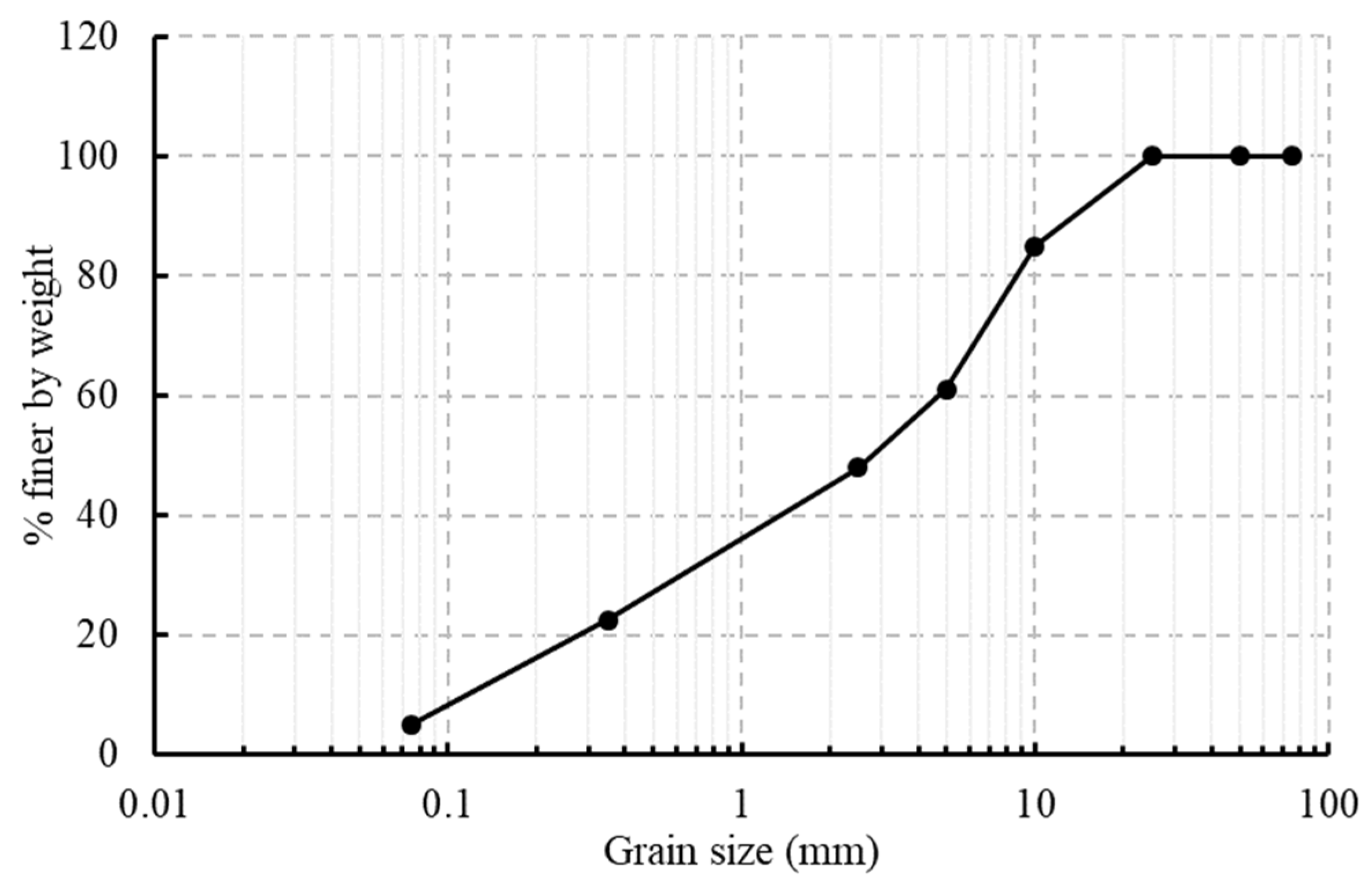
2.2. Description of the Equipment Used
2.3. Description of Devices and Tools
2.4. Compaction Control of Backfill Soil
2.5. Applied Load
2.6. Installation Method of GRP Pipes
2.7. Test Variable
3. Analysis of Experimental Results
4. Finite Element Analysis
4.1. Elements
4.2. Boundary Conditions
4.3. Verification Results
5. Parametric Studies
5.1. Bedding Depth
5.2. Backfill Depth
5.3. Pipe Diameter
5.4. Pipe Thickness
5.5. Comparison between Steel and GRP Pipes
5.6. Normal Forces in GRP Pipes
6. Conclusions
- For the 1400 mm diameter GRP pipes, minimum backfill covers of 75 cm and 50 cm were suitable and can be used for local practice of backfilling for both earth fill loading and traffic loading.
- The experimental results showed that as the backfill cover increased the maximum deflection decreased. The percentages of the deflection reduction were 38% for a backfill increase from 50 cm to 100 cm and 33.33% for a backfill increase from 50 cm to 75 cm.
- The FE results indicated that the crown deflection increased by 22.7%, 26.5%, and 48.7% when the pipe diameter increased from 1.00 m to 1.50 m, 2.00 m and 2.50 m, respectively. On the other hand, the invert deflection decreased by 17.2%, 21.5%, and 25.1% when the pipe diameter increased from 1.0 m to 1.5 m, 2.0 m, and 2.5 m, respectively.
- The pipe deflection decreased by increasing the pipe thickness where the crown deflection reduced by 4.8, 10.6, 15.7, and 20.8% when the pipe thickness increased from 15 mm to 20, 25, 30, and 35 mm, respectively.
- The deflections of the steel pipe were lower than those of the GRP pipe when using different thicknesses.
- As the backfill cover increases, the maximum deflection decreases due to the load distribution effect, where an increased backfill cover reduces the traffic load applied on the pipe by a 1:2 ratio.
Author Contributions
Funding
Data Availability Statement
Acknowledgments
Conflicts of Interest
References
- Jiang, N.; Zhu, B.; Zhou, C.; Li, H.; Wu, B.; Yao, Y.; Wu, T. Blasting vibration effect on the buried pipeline: A brief overview. Eng. Fail. Anal. 2021, 129, 105709. [Google Scholar] [CrossRef]
- Jiang, X.; Zhang, X.; Zhang, X.; Long, L.; Bai, Y.; Huang, B. Advancing Shallow Tunnel Construction in Soft Ground: The Pipe-Umbrella Box Jacking Method. Transp. Res. Rec. 2024. [Google Scholar] [CrossRef]
- Jiang, X.; Zhang, X.; Wang, S.; Bai, Y.; Huang, B. Case Study of the Largest Concrete Earth Pressure Balance Pipe-Jacking Project in the World. Transp. Res. Rec. 2022, 2676, 92–105. [Google Scholar] [CrossRef]
- Arockiasamy, M.; Chaallal, O.; Limpeteeprakarn, T. Full-Scale Field Tests on Flexible Pipes under Live Load Application. J. Perform. Constr. Facil. 2006, 20, 21–27. [Google Scholar] [CrossRef]
- Al-Mosawe, M.J.; Said, A.M.; Dawood, A.O. Investigation of Backfill Compaction Effect on Buried Concrete Pipes. J. Eng. 2013, 19, 180–196. [Google Scholar] [CrossRef]
- Ali, A.F.; Sehaib, R. Effects of Bedding Types on the Behavior of Large Diameter GRP Flexible Sewer Pipes. J. Eng. 2017, 23, 136–155. [Google Scholar] [CrossRef]
- BS EN 1295-1; Structural Design of Buried Pipelines under Various Conditions of Loading General Requirements. British Standards Institution: London, UK, 2019.
- Fattah, M.Y.; Zbar, B.S.; Al-Kalali, H.H.M. Three-Dimensional Finite Element Simulation of the Buried Pipe Problem in Geogrid Reinforced Soil. Glob. J. Eng. Sci. Res. Manag. 2016, 3, 118–128. [Google Scholar] [CrossRef]
- Dawood, M.; Izzet, A.F.; Khudair, B.H. Comparative Study between the Behavior of the Concrete Thrust Block and the Restraint Joint in a Water Distribution System; Review. J. Eng. 2022, 28, 1–10. [Google Scholar] [CrossRef]
- Chaallal, O.; Arockiasamy, M.; Godat, A. Numerical Finite-Element Investigation of the Parameters Influencing the Behavior of Flexible Pipes for Culverts and Storm Sewers under Truck Load. J. Pipeline Syst. Eng. Pract. 2014, 6, 04014015. [Google Scholar] [CrossRef]
- Liu, B.; Wang, Z.; Xu, W.; Sun, H.; Wang, X. Comparative Experimental Study and FE Analysis of Corrugated Steel Pipe Culverts with Different Stiffness. Open Civ. Eng. J. 2016, 10, 549–563. [Google Scholar] [CrossRef]
- Saleh, A.E.; Jalali, H.H.; Pokharel, A.; Abolmaali, A. Deformation of buried large diameter steel pipes during staged construction and compaction-case study and finite element analysis. Transp. Geotech. 2021, 31, 100649. [Google Scholar] [CrossRef]
- Daradkeh, A.M.; Jalali, H.H. Finite Element Modeling Aspects of Buried Large Diameter Steel Pipe–Butterfly Valve Interaction. Modelling 2023, 4, 548–566. [Google Scholar] [CrossRef]
- Plaxis 3D: 3D Geotechnical Engineering Software. American Bentley Systems, Inc.: Exton, PA, USA, 2013.
- BS-5480; Specification for Glass Reinforced Plastics (GRP) Pipes, Joints and Fittings for Use for Water Supply or Sewerage. British Standards Institution: London, UK, 2006.
- ASTM D422-63; Standard Test Method for Particle-Size Analysis of Soils. American Society for Testing and Materials: Franklin, MA, USA, 2007.
- American Association of State Highway and Transportation Officials. AASHTO LRFD Bridge Design Specifications, 8th ed.; American Association of State Highway and Transportation Officials: Washington, DC, USA, 2017. [Google Scholar]
- ASTM D3839-14; Standard Guide for Underground Installation of “Fiberglass” (Glass-Fiber Reinforced Thermosetting-Resin) Pipe. American Society for Testing and Materials: Franklin, MA, USA, 2019. [CrossRef]
- ASTM D2487-17; Standard Practice for Classification of Soils for Engineering Purposes (Unified Soil Classification System). American Society for Testing and Materials: Franklin, MA, USA, 2017. [CrossRef]
- AASHTO M145; Standard Specification for Classification of Soils and Soil-Aggregate Mixtures for Highway Construction Purposes. American Association of State Highway and Transportation Officials: Washington, DC, USA, 2018.
- AASHTO T-90; Standard Method of Test for Determining the Plastic Limit and Plasticity Index of Soils. American Association of State Highway and Transportation Officials: Washington, DC, USA, 2020.
- ASTM D698-12; Standard Test Methods for Laboratory Compaction Characteristics of Soil Using Standard Effort. American Society for Testing and Materials: Franklin, MA, USA, 2021. [CrossRef]
- AASHTO T-180; Standard Method of Test for Moisture–Density Relations of Soils Using a 4.54-kg (10-lb) Rammer and a 457-mm (18-in.) Drop. American Association of State Highway and Transportation Officials: Washington, DC, USA, 2020.
- ASTM D1557-12; Standard Test Methods for Laboratory Compaction Characteristics of Soil Using Modified Effort. American Society for Testing and Materials: Franklin, MA, USA, 2021. [CrossRef]
- American Water Works Association. AWWA M45: Fiberglass Pipe Design, 13th ed.; American Water Works Association: Denver, CO, USA, 2013. [Google Scholar]
- Schanz, T.; Vermeer, P.A.; Bonnier, P.G. The hardening soil model: Formulation and verification. In Beyond 2000 in Computational Geotechnics; Ten years of Plaxis International. Proceedings of the international symposium; Routledge: Abingdon-on-Thames, UK, 1999; pp. 281–296. [Google Scholar]
- Duncan, J.M.; Chang, C.Y. Nonlinear analysis of stress and strain in soils. J. Soil Mech. Found. Div. 1970, 96, 1629–1653. [Google Scholar] [CrossRef]
- Saleh, S.; Mohd Yunus, N.Z.; Ahmad, K.; Mat Said, K.N. Numerical simulation with hardening soil model parameters of marine clay obtained from conventional tests. SN Appl. Sci. 2021, 3, 156. [Google Scholar] [CrossRef]
- Shi, X.; Sun, J.; Qi, Y.; Zhu, X.; Zhang, X.; Liang, R.; Chen, H. Study on Stiffness Parameters of the Hardening Soil Model in Sandy Gravel Stratum. Appl. Sci. 2023, 13, 2710. [Google Scholar] [CrossRef]



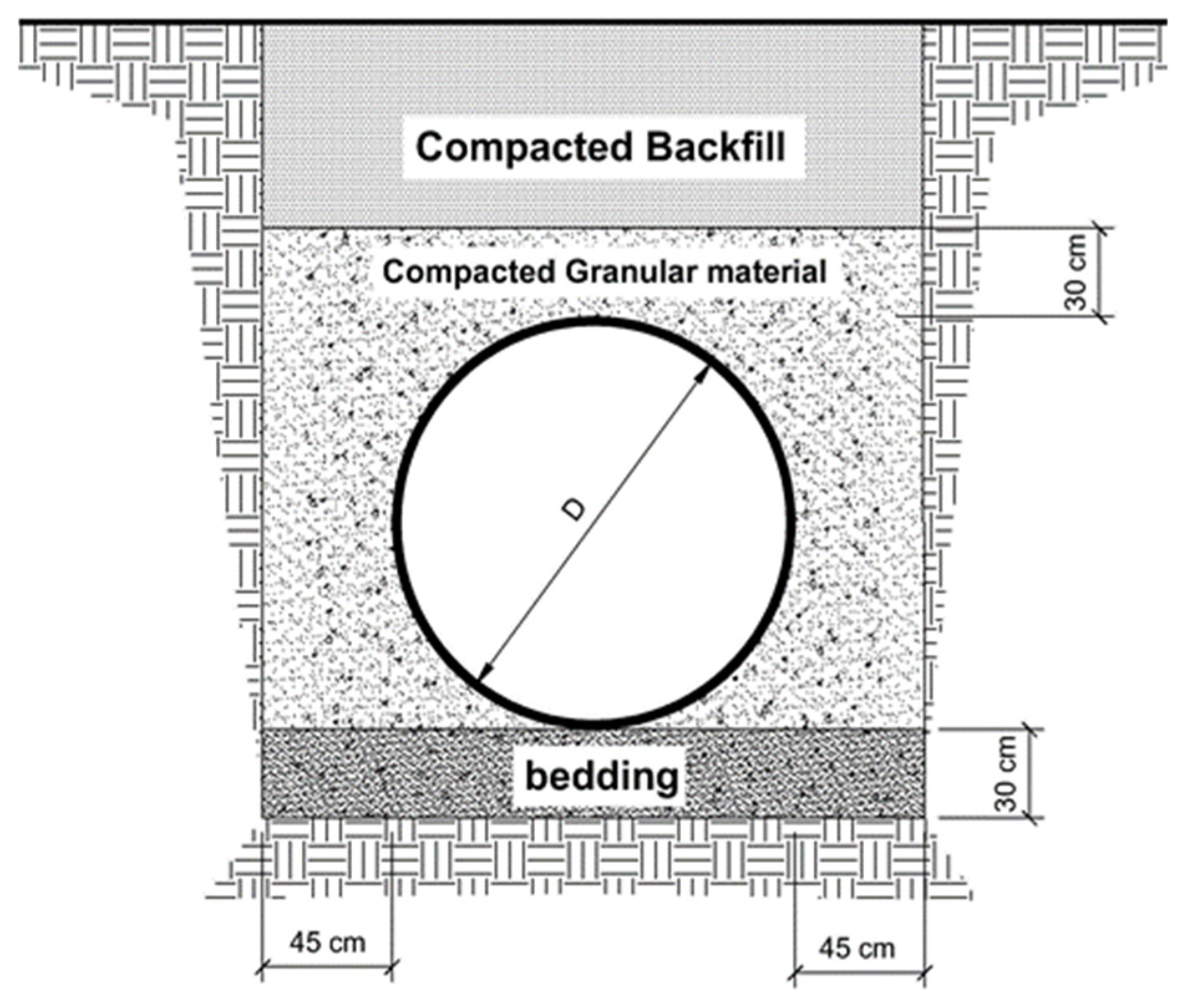
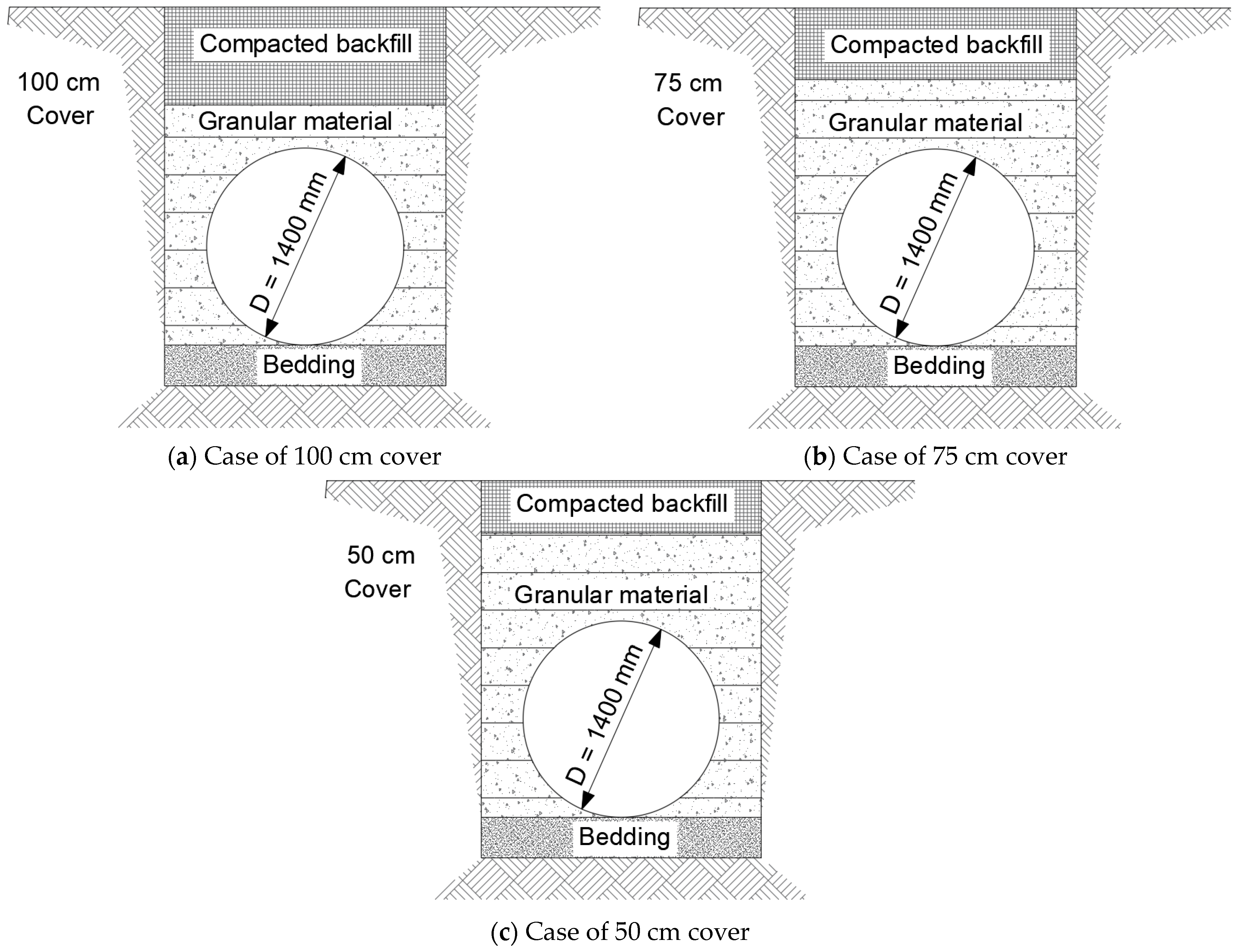

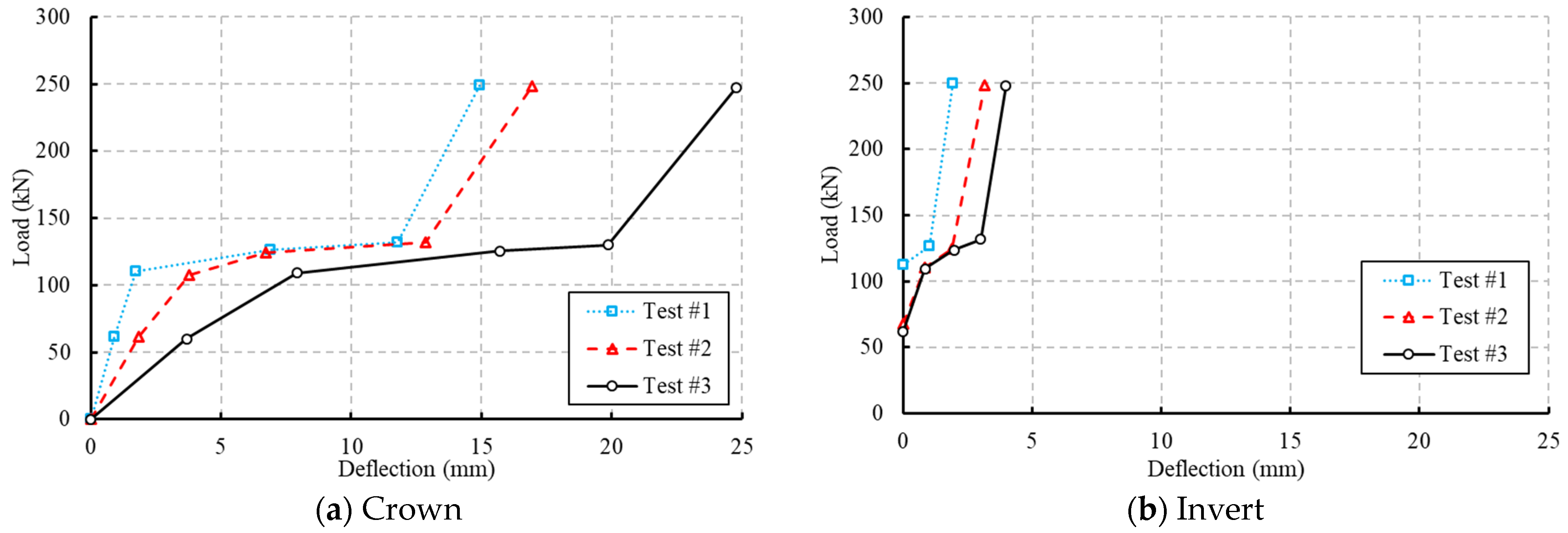



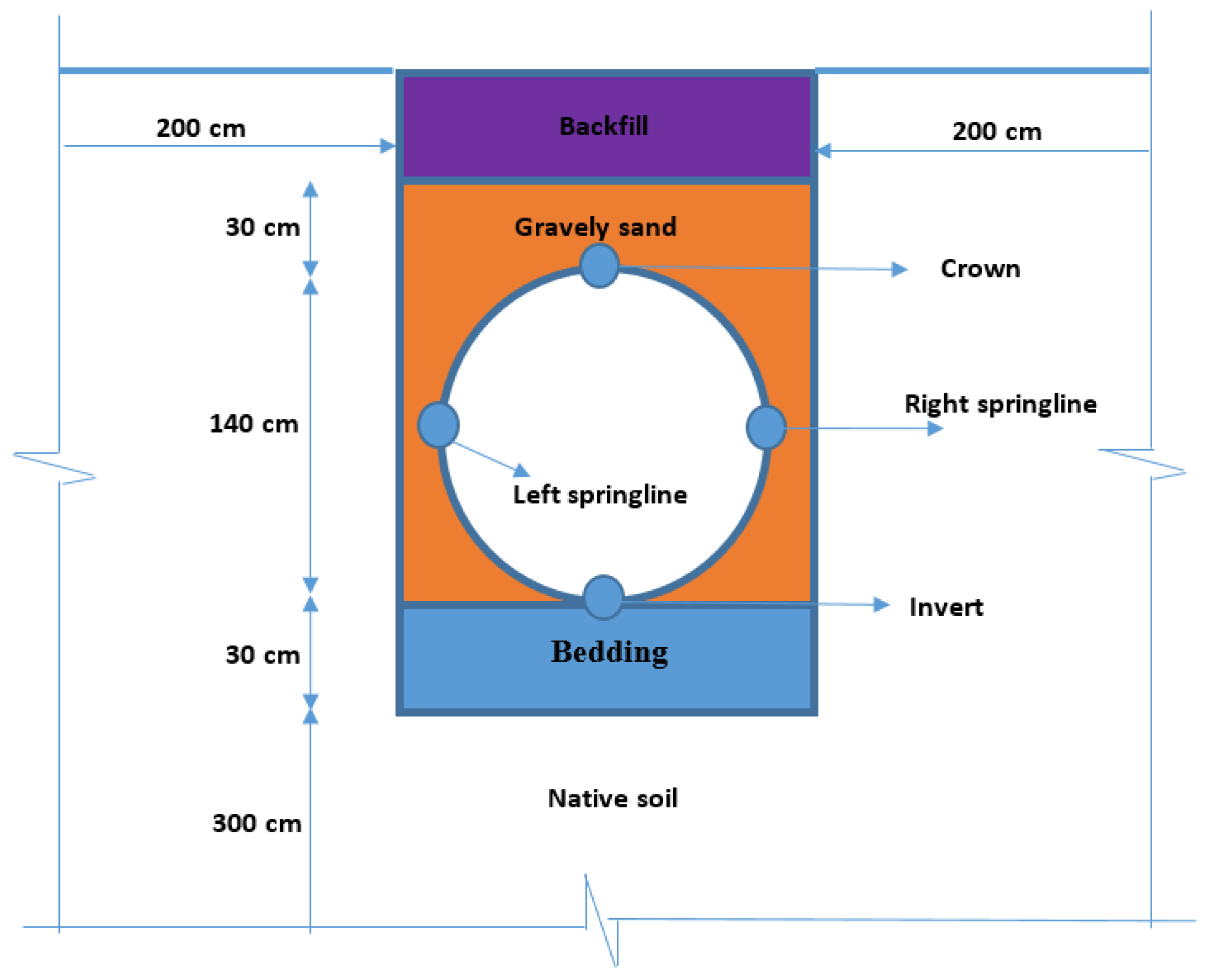
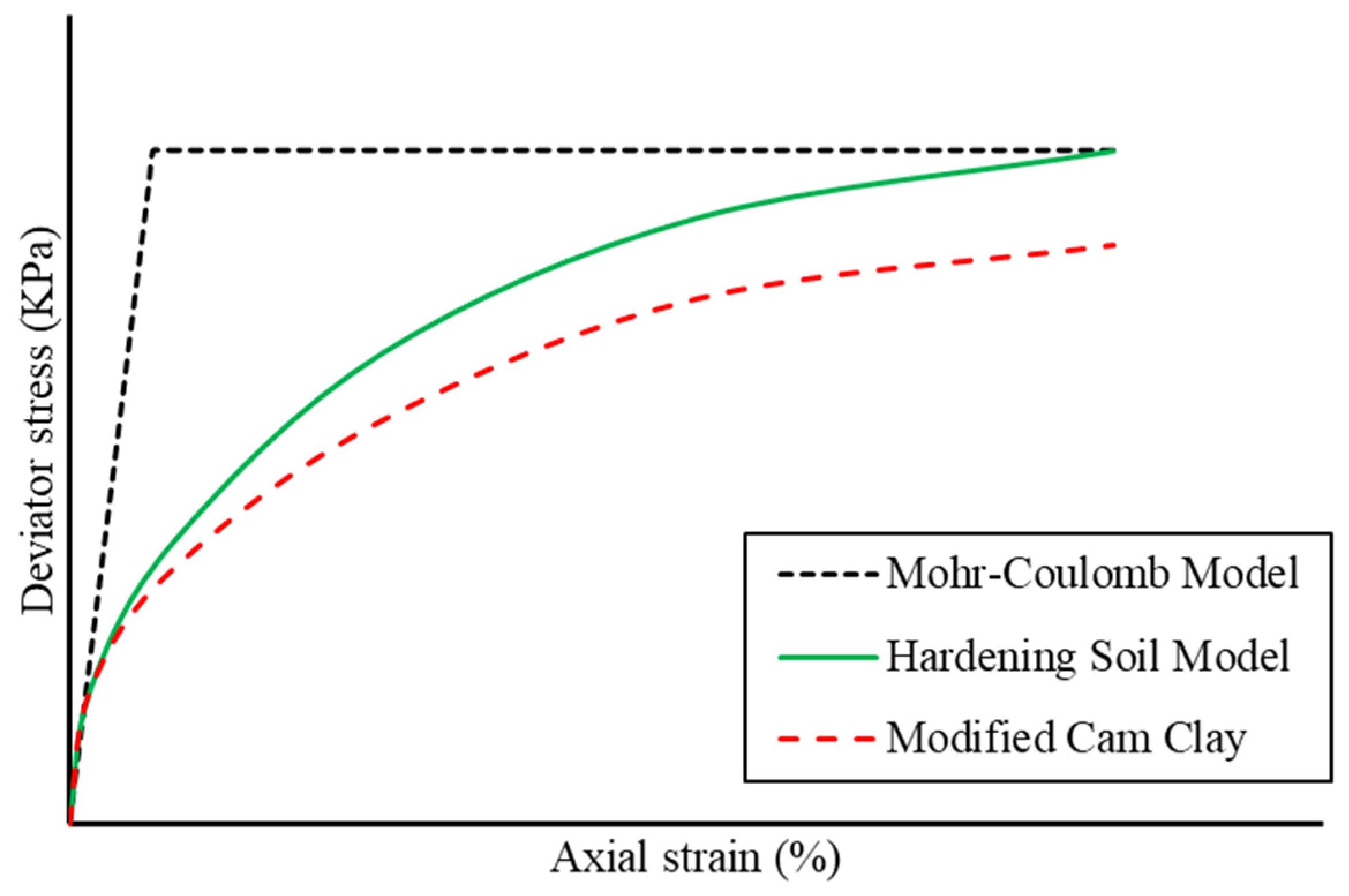
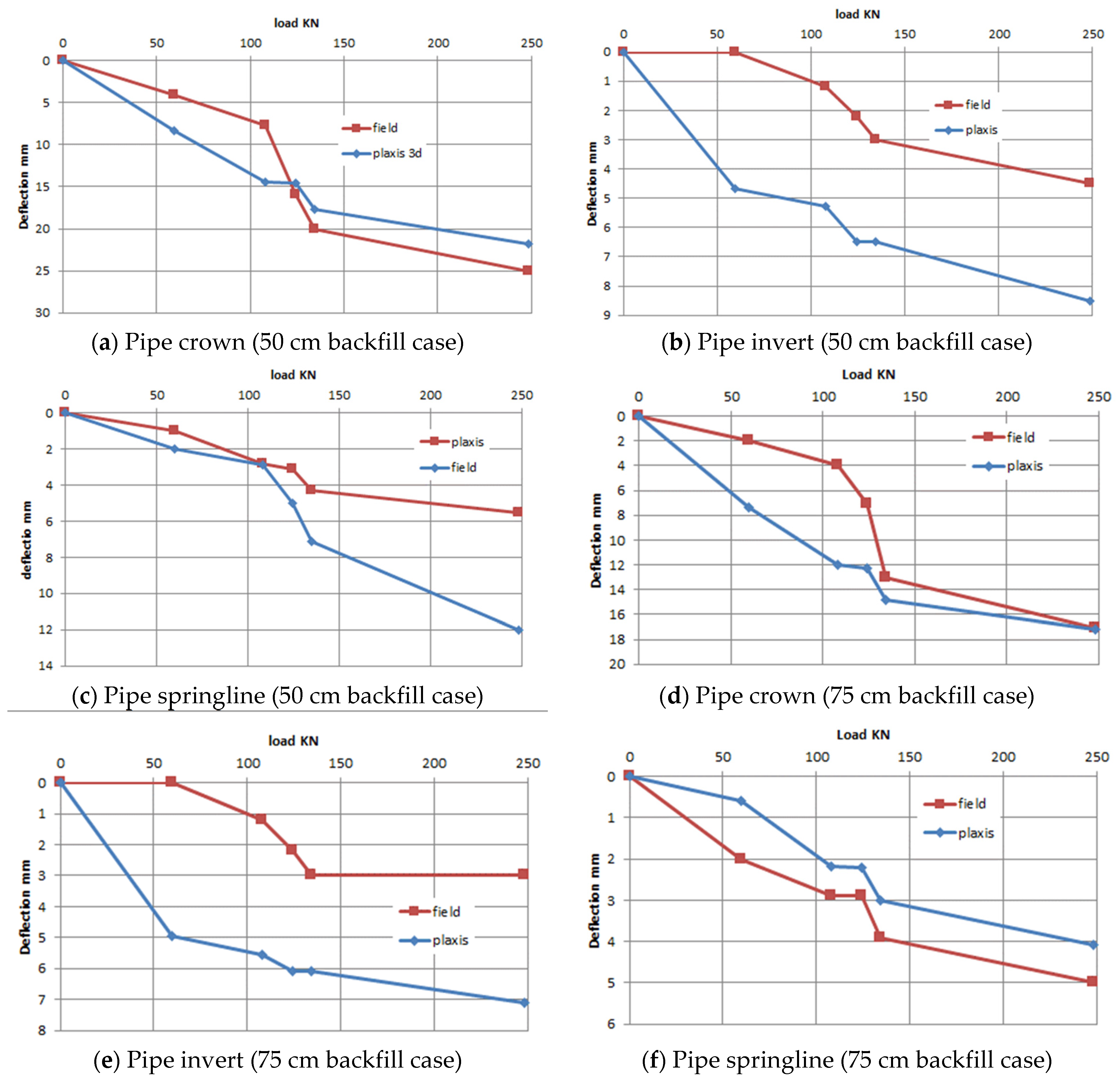
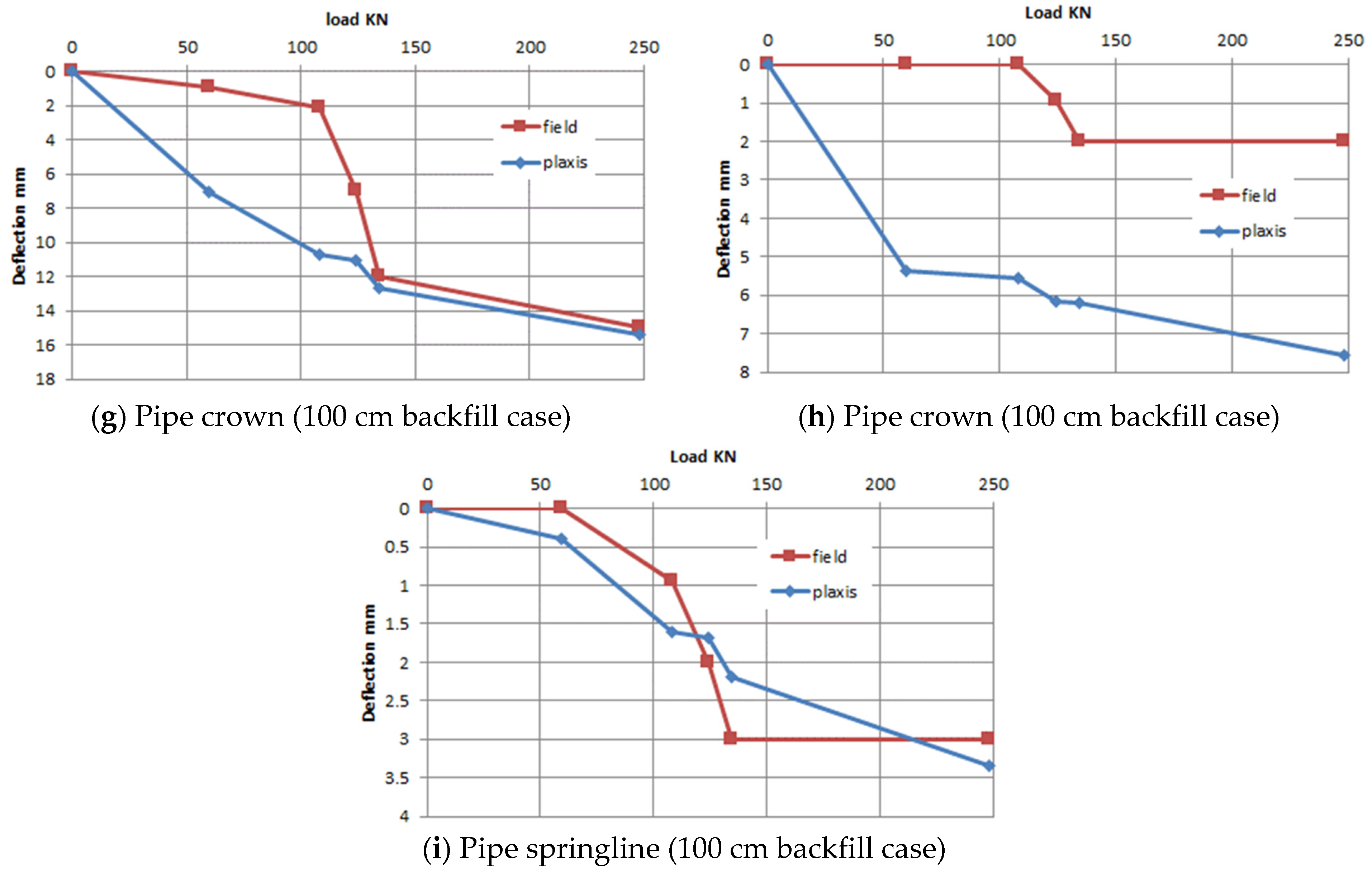
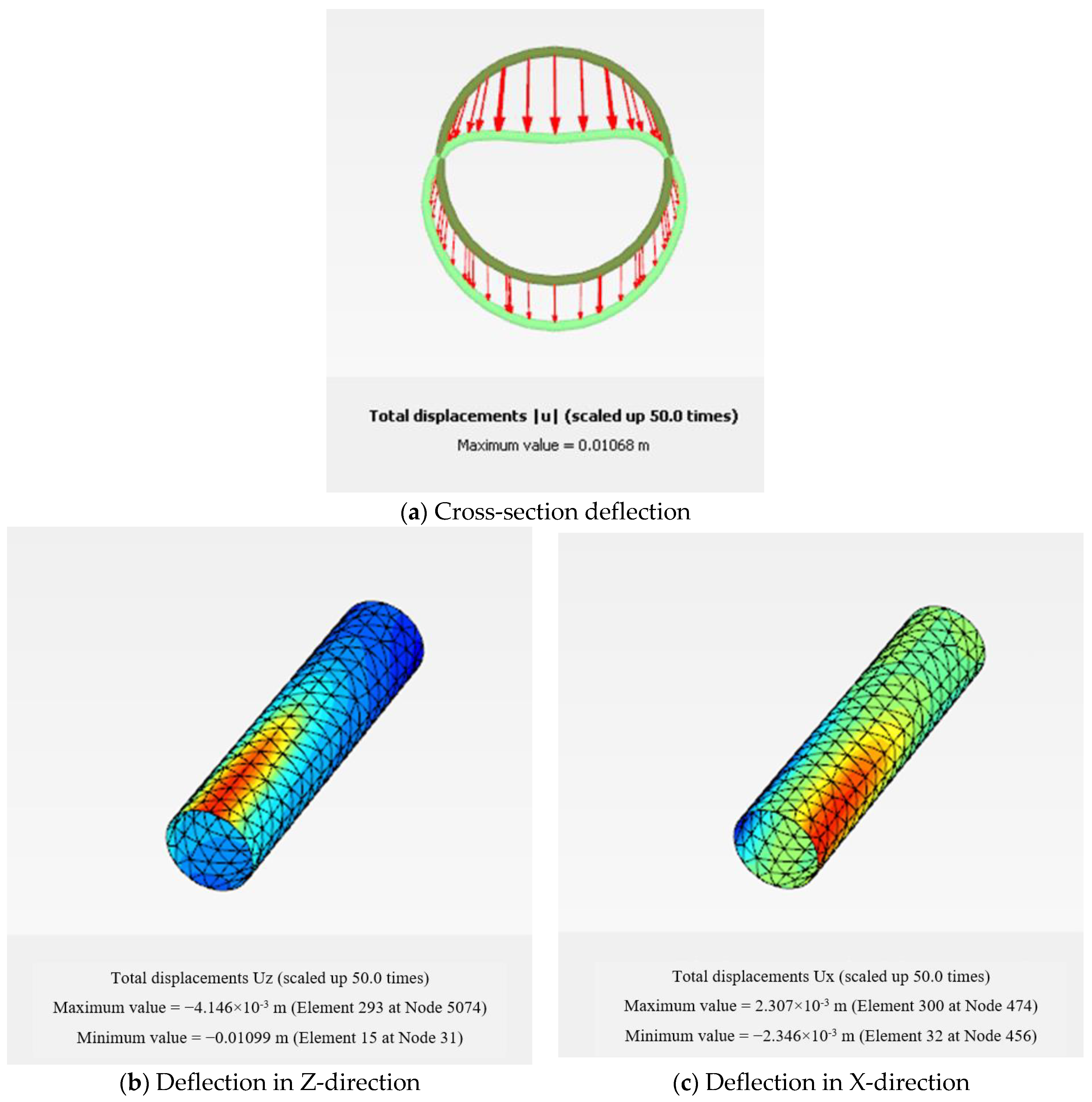

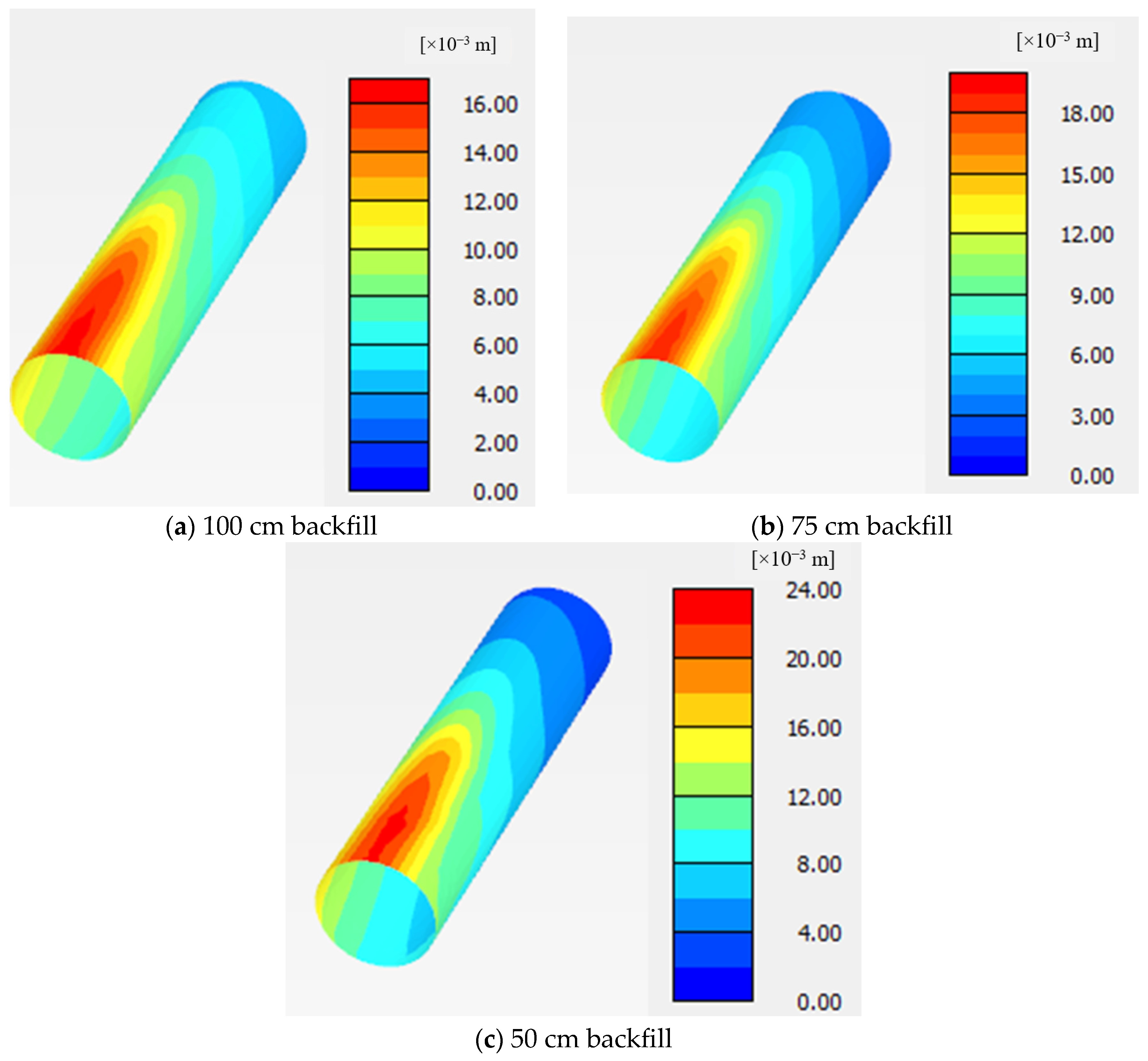



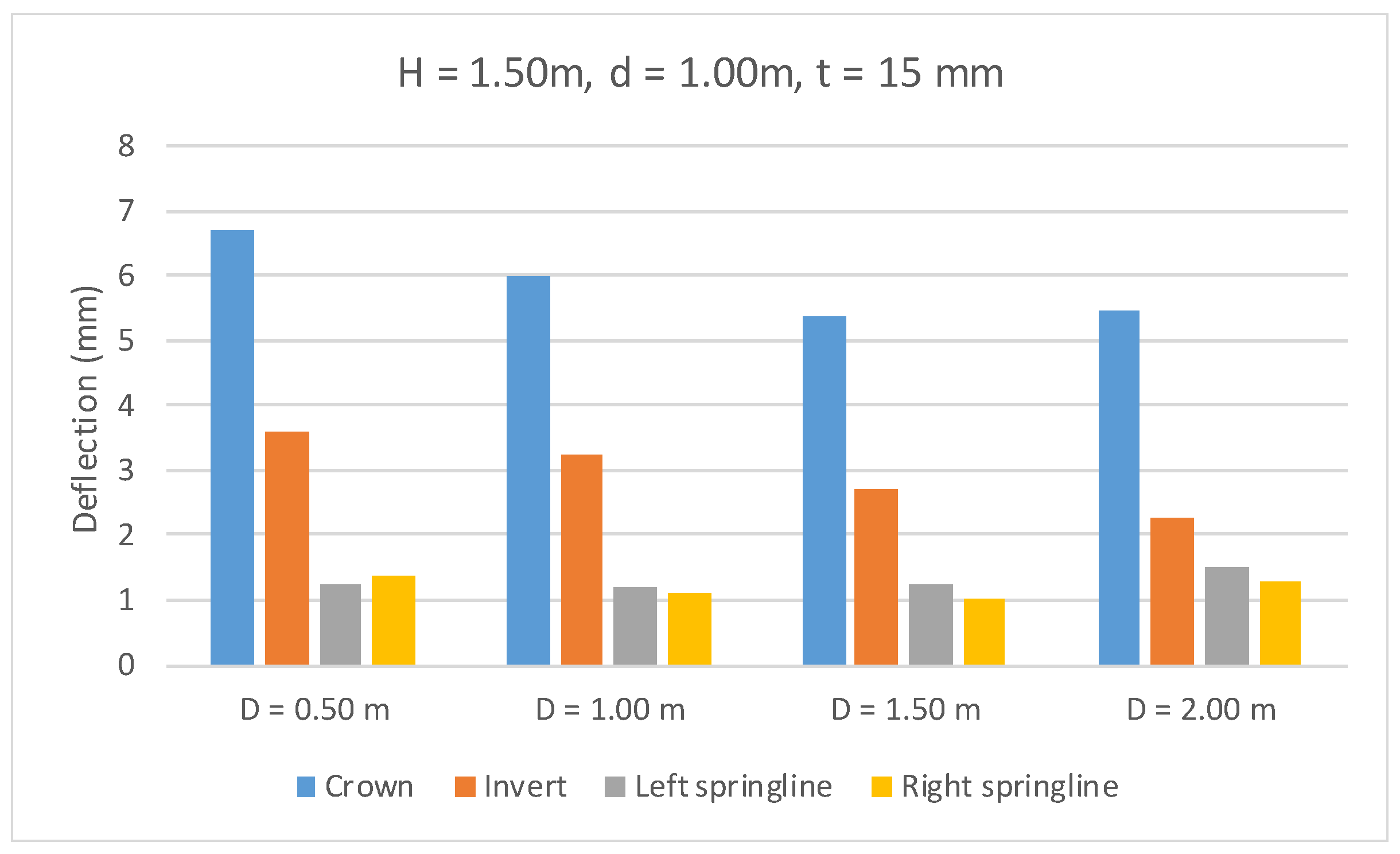
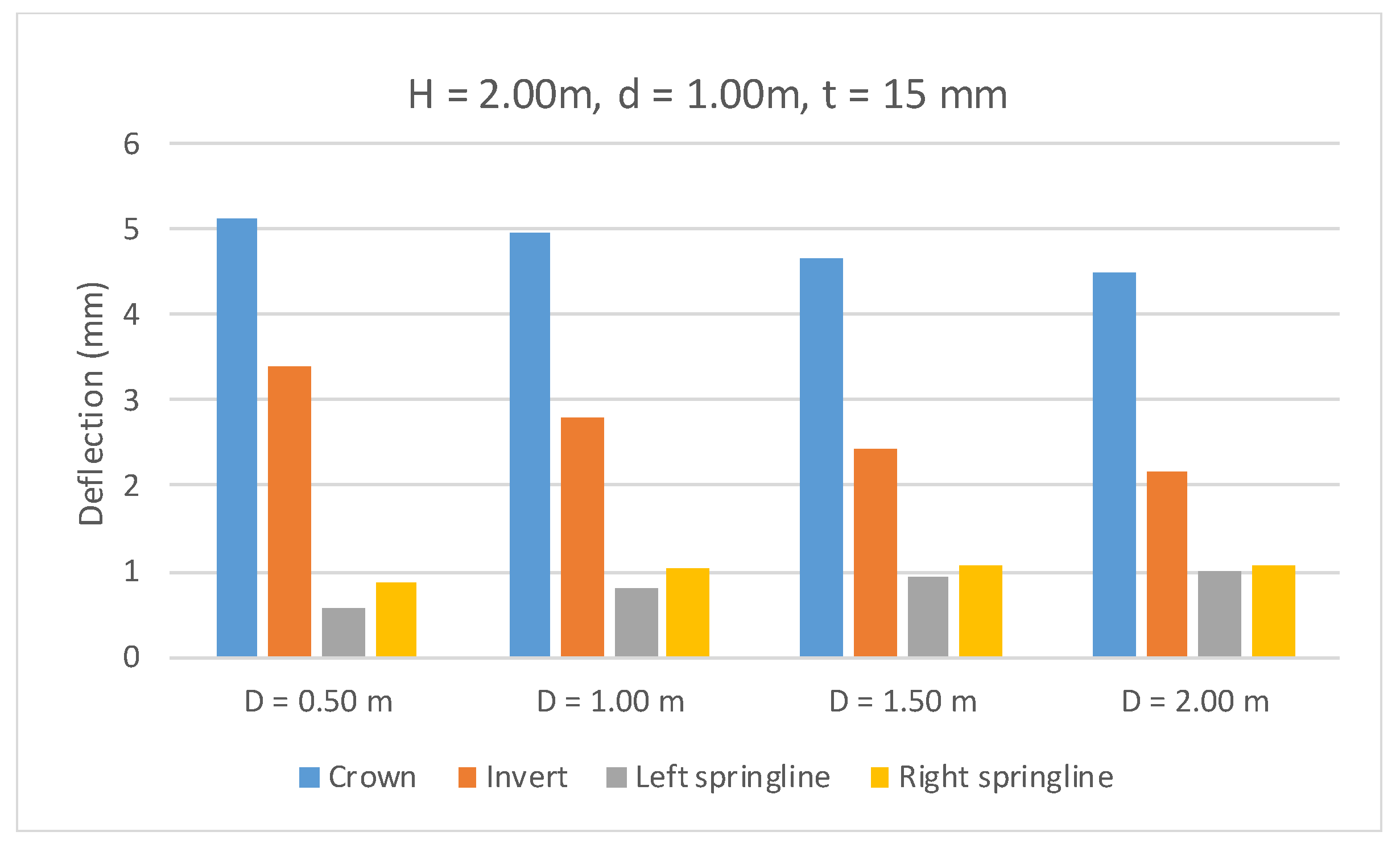

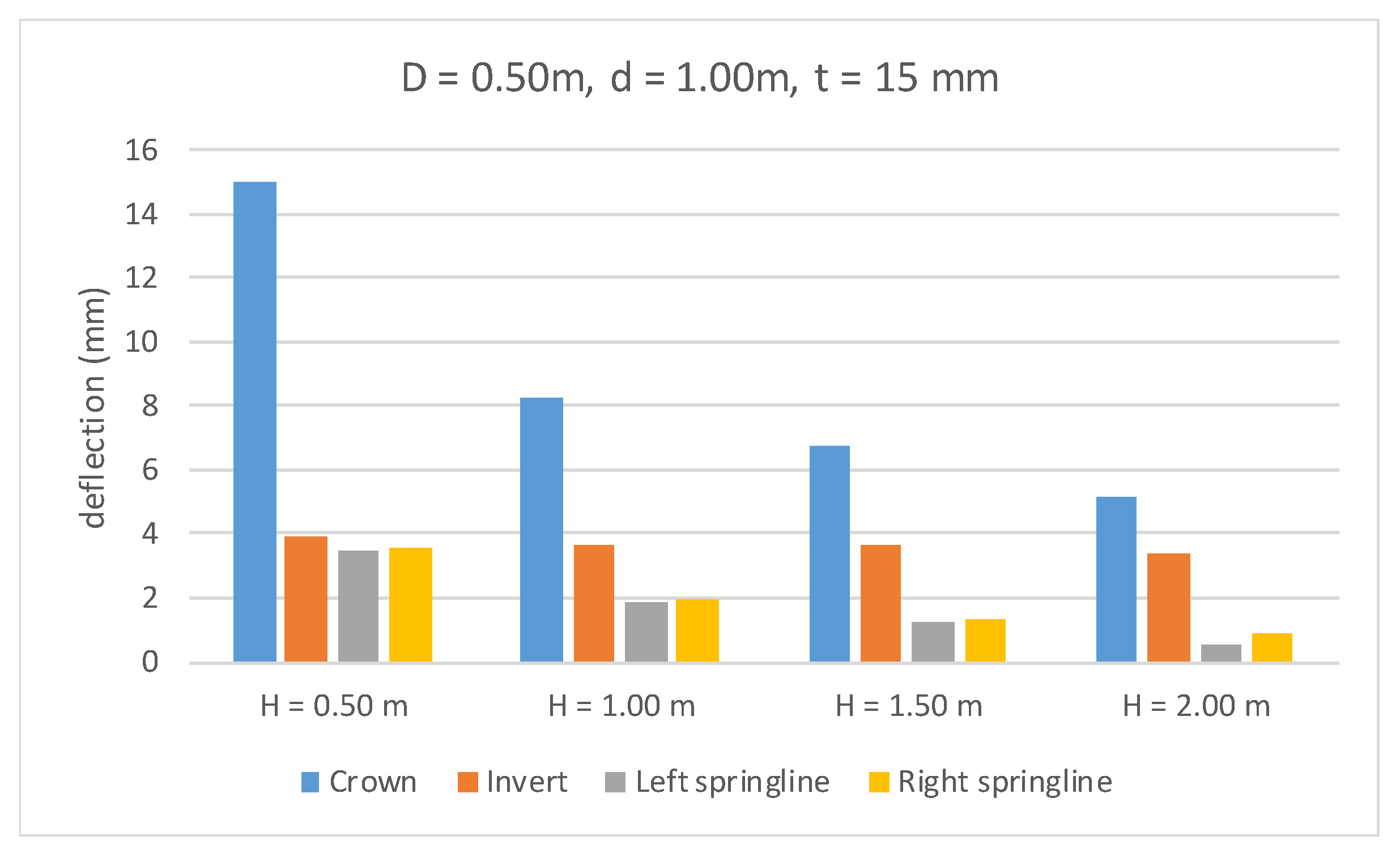
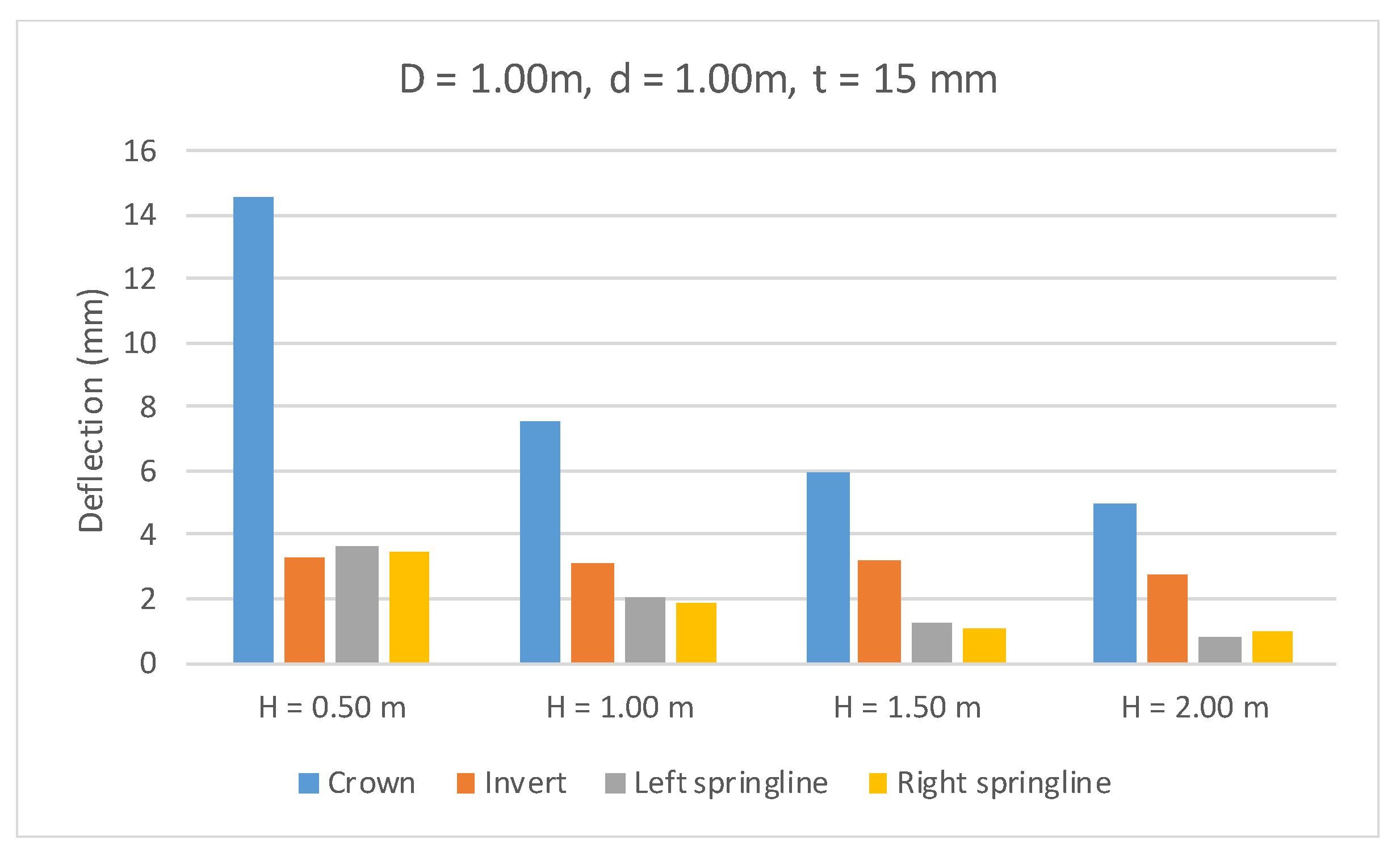
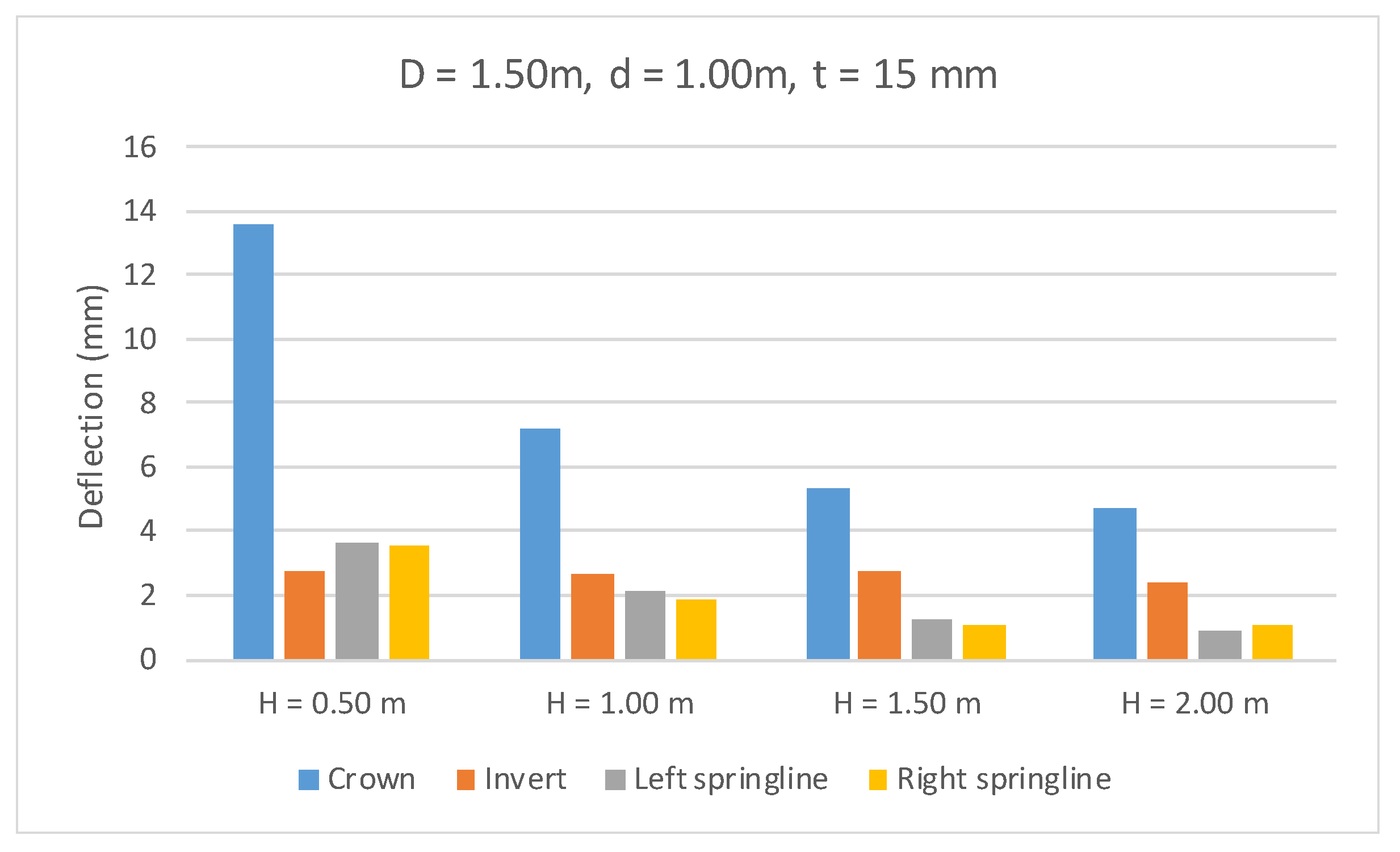
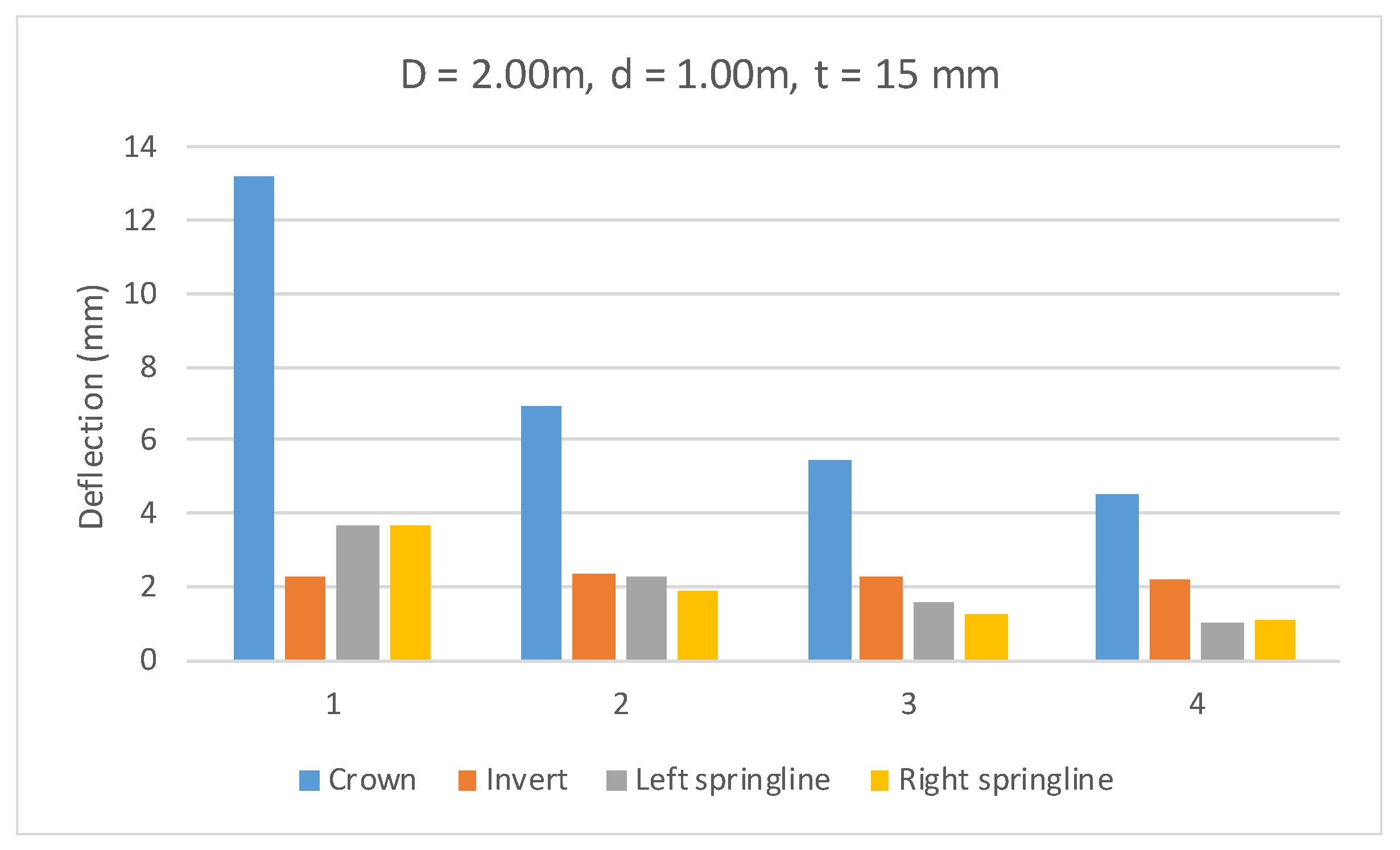


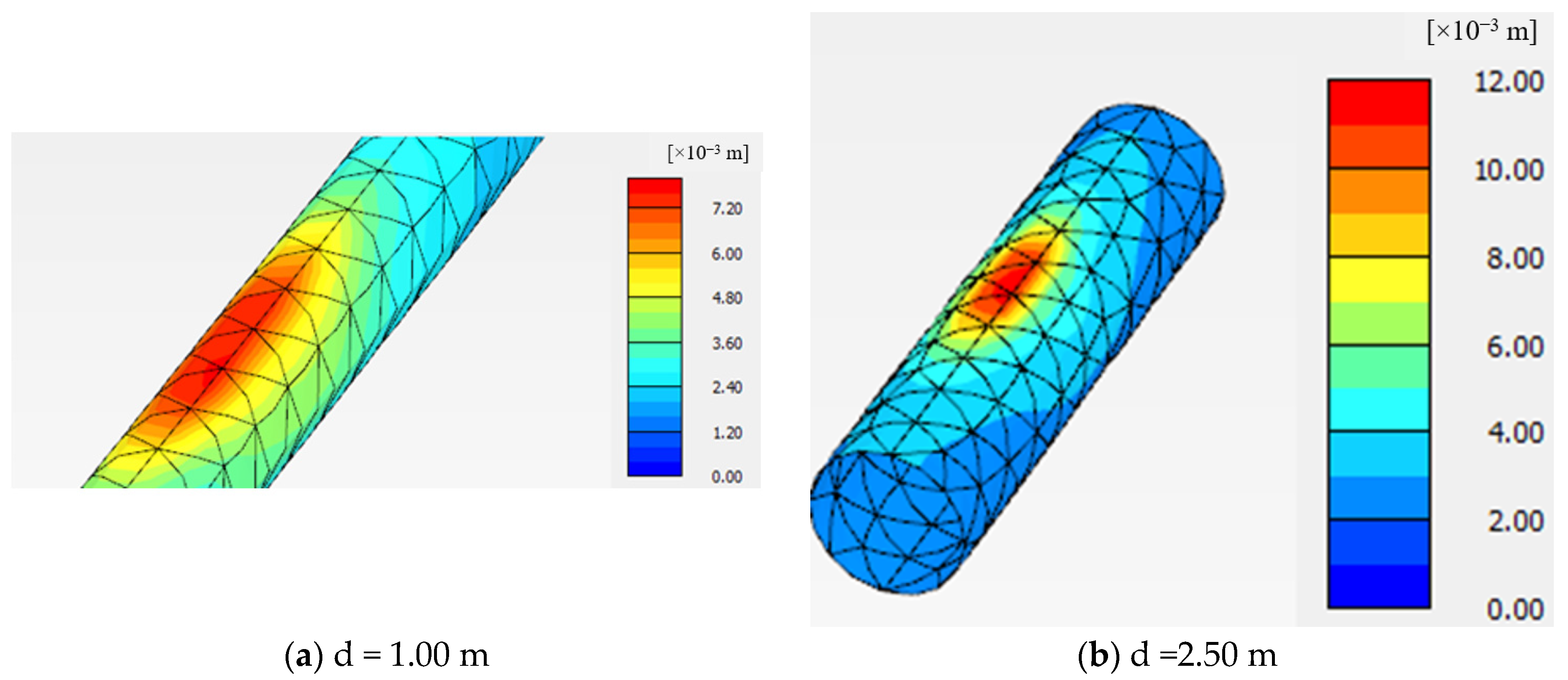
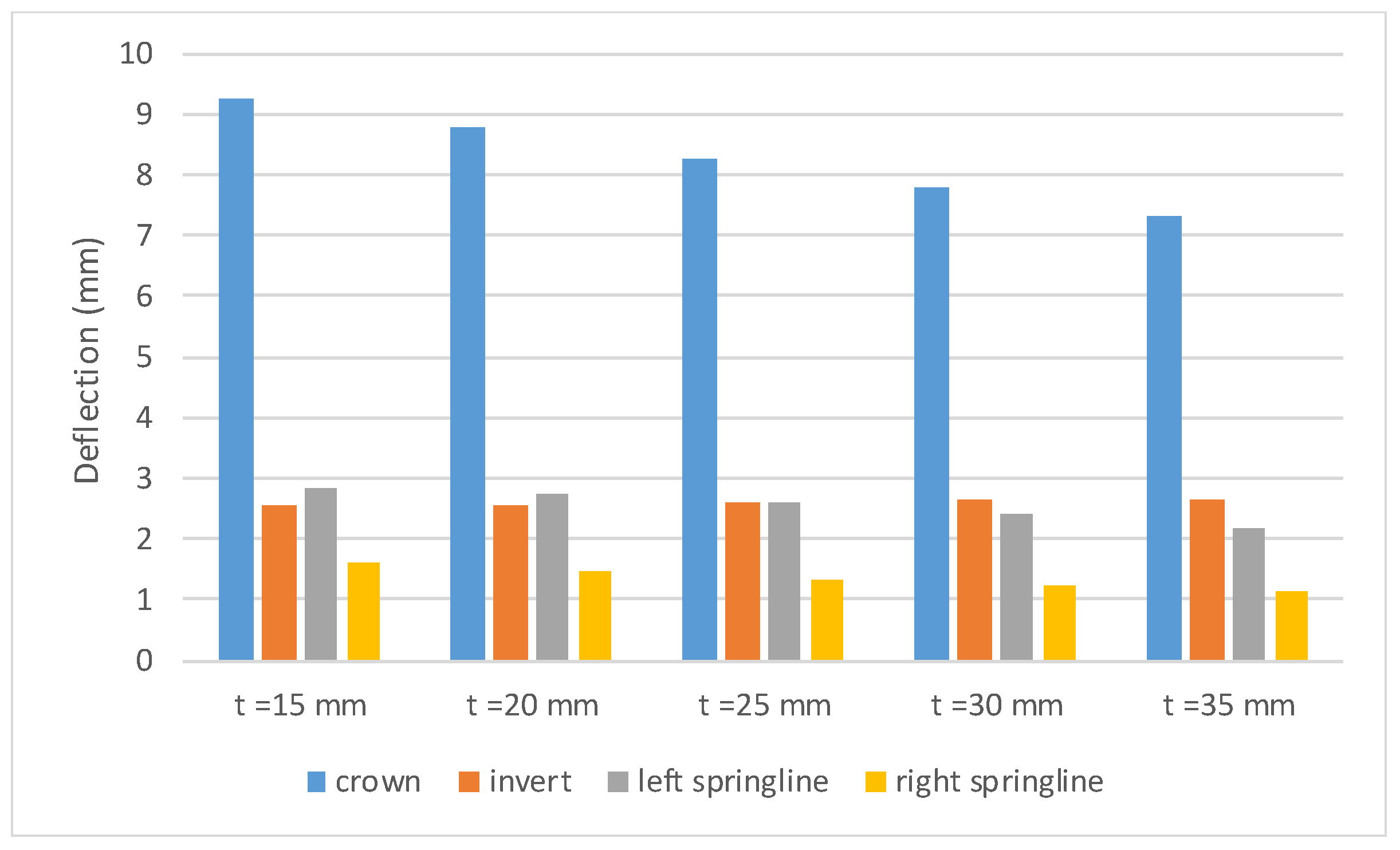
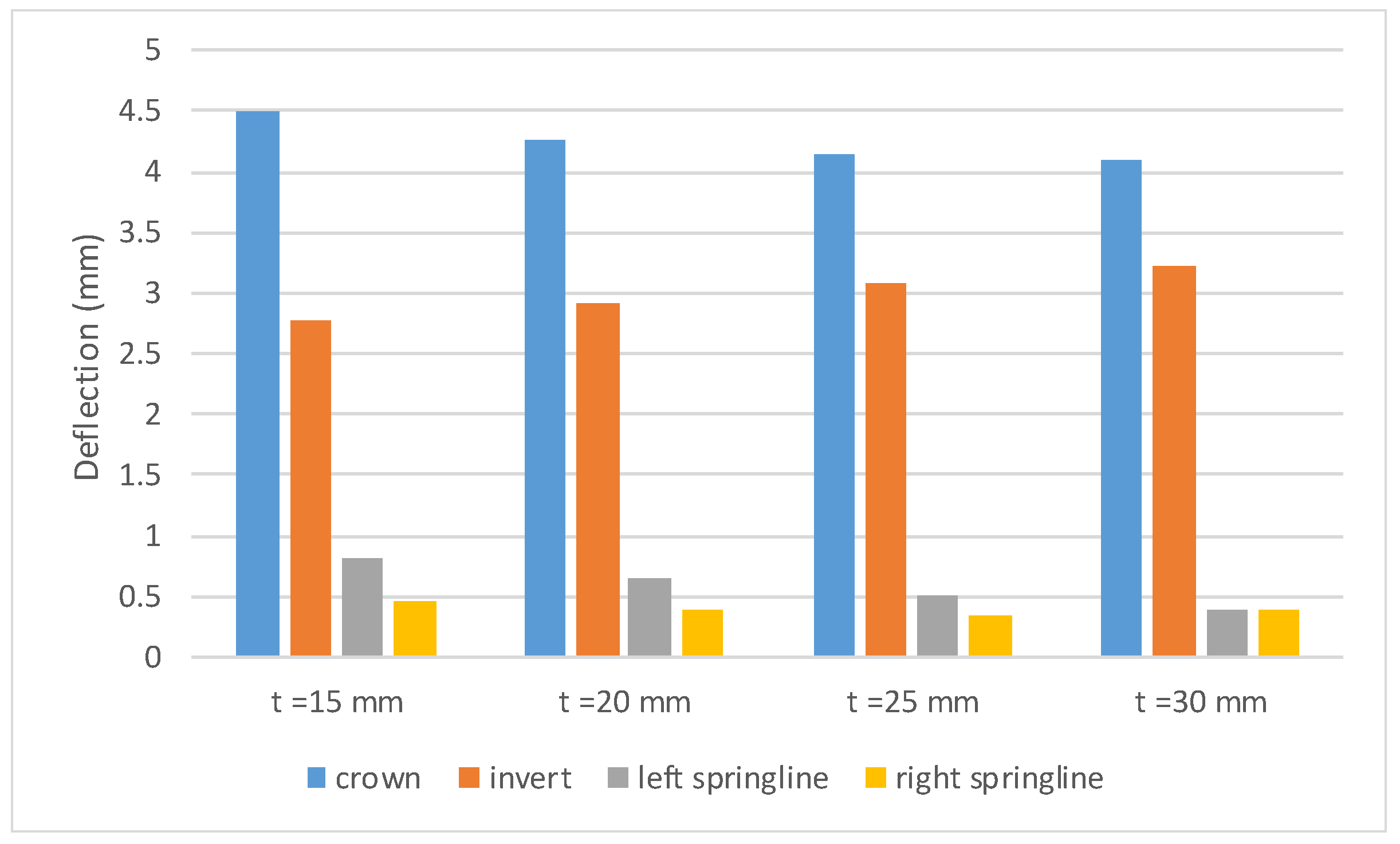
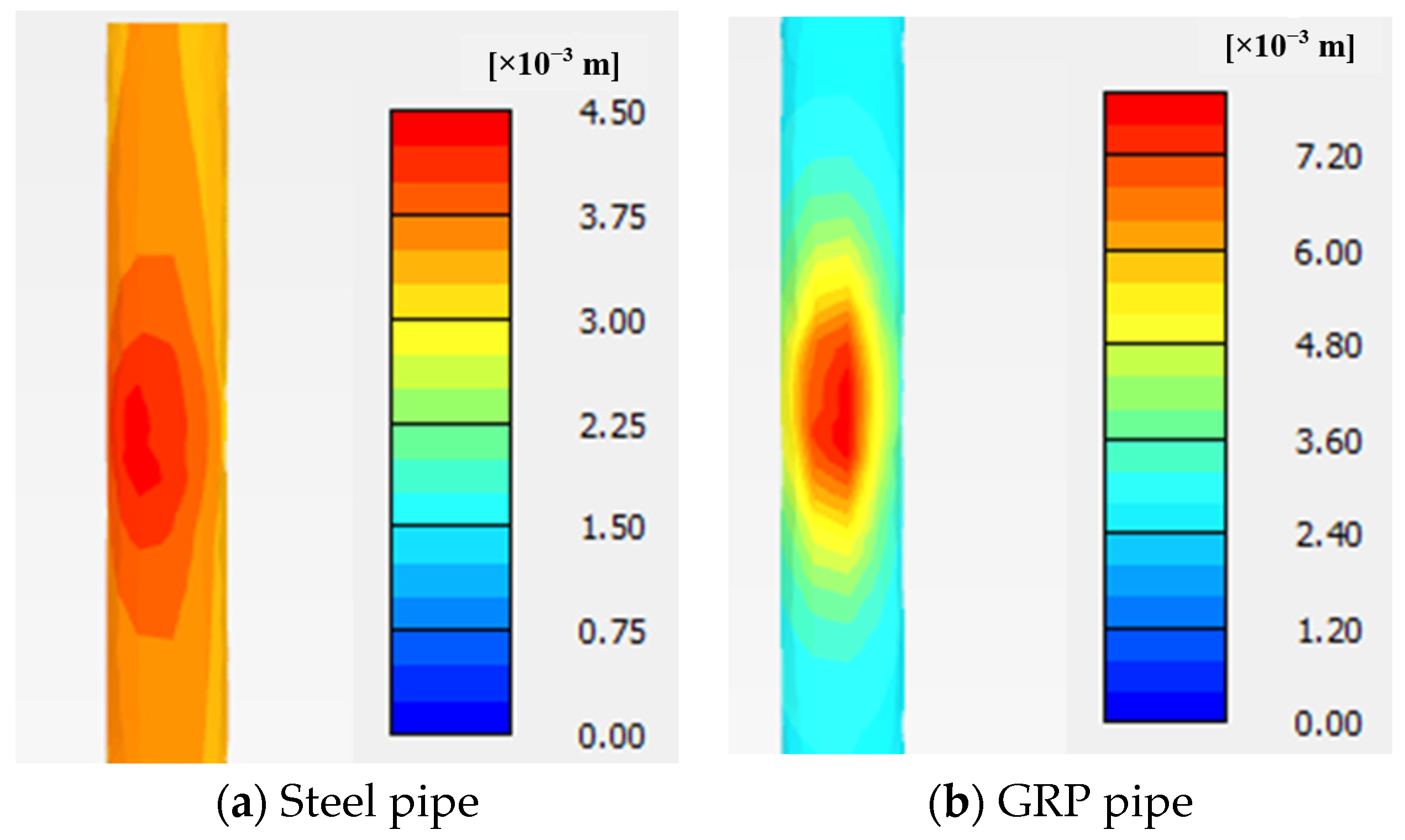
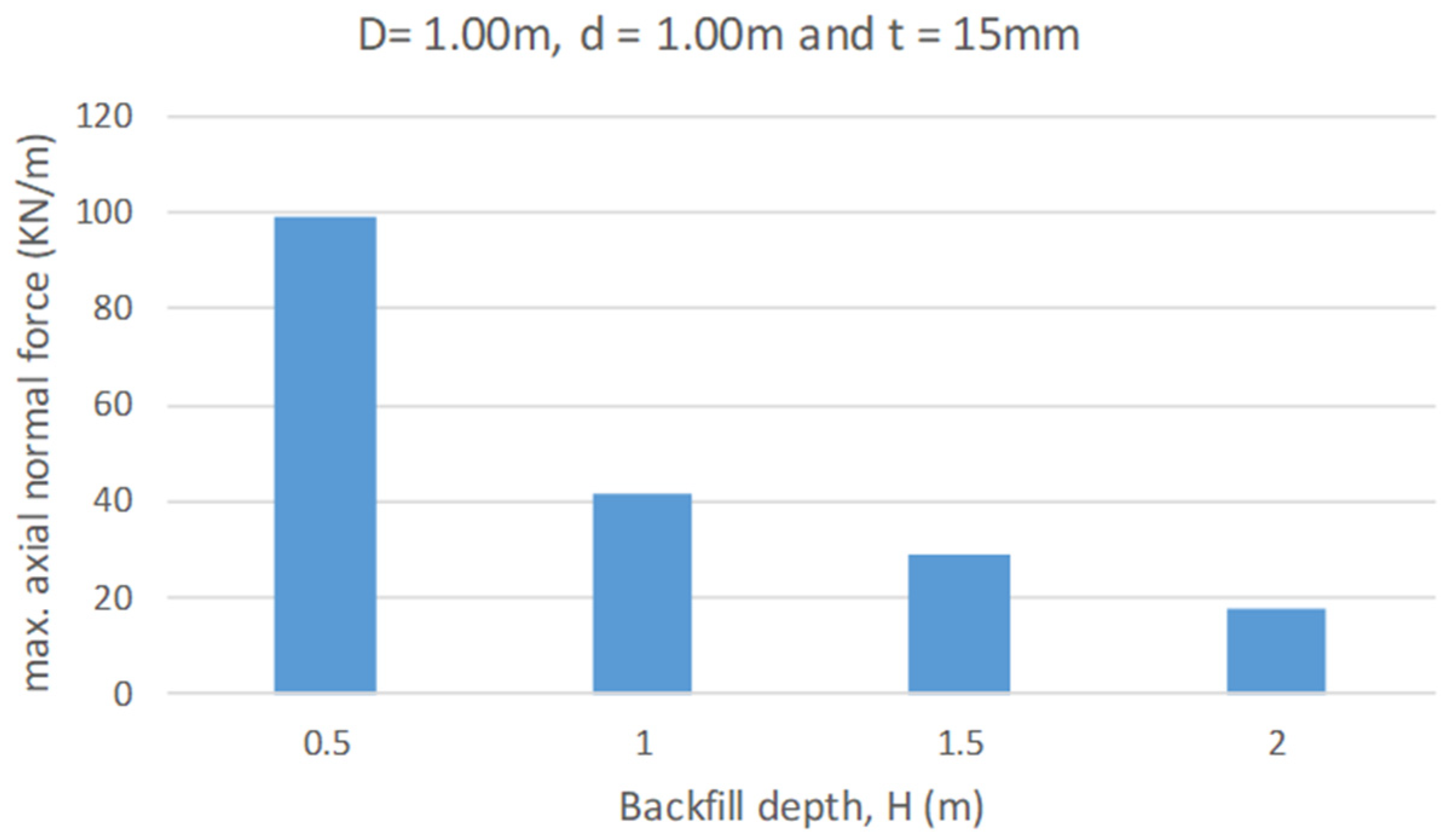
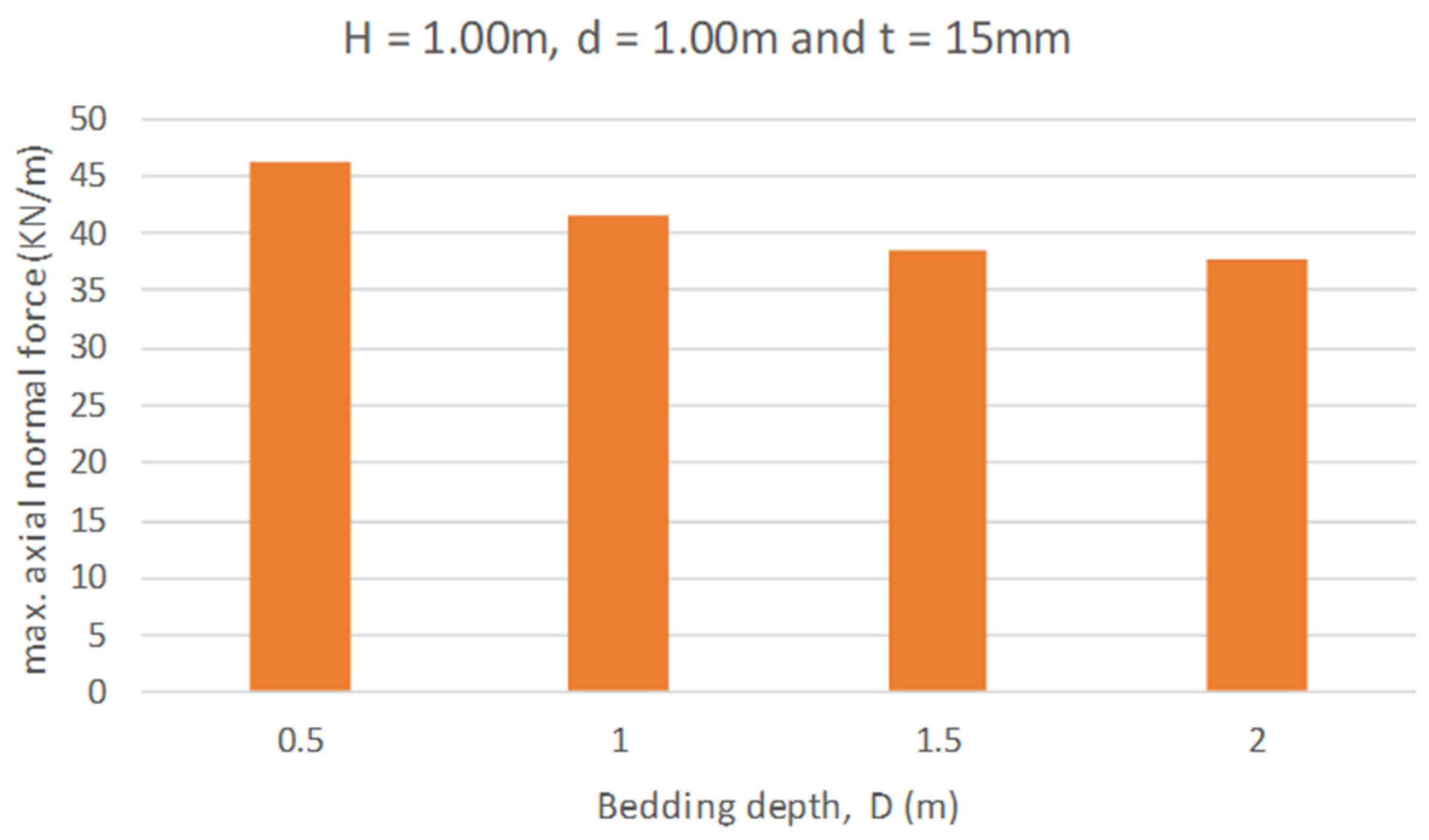
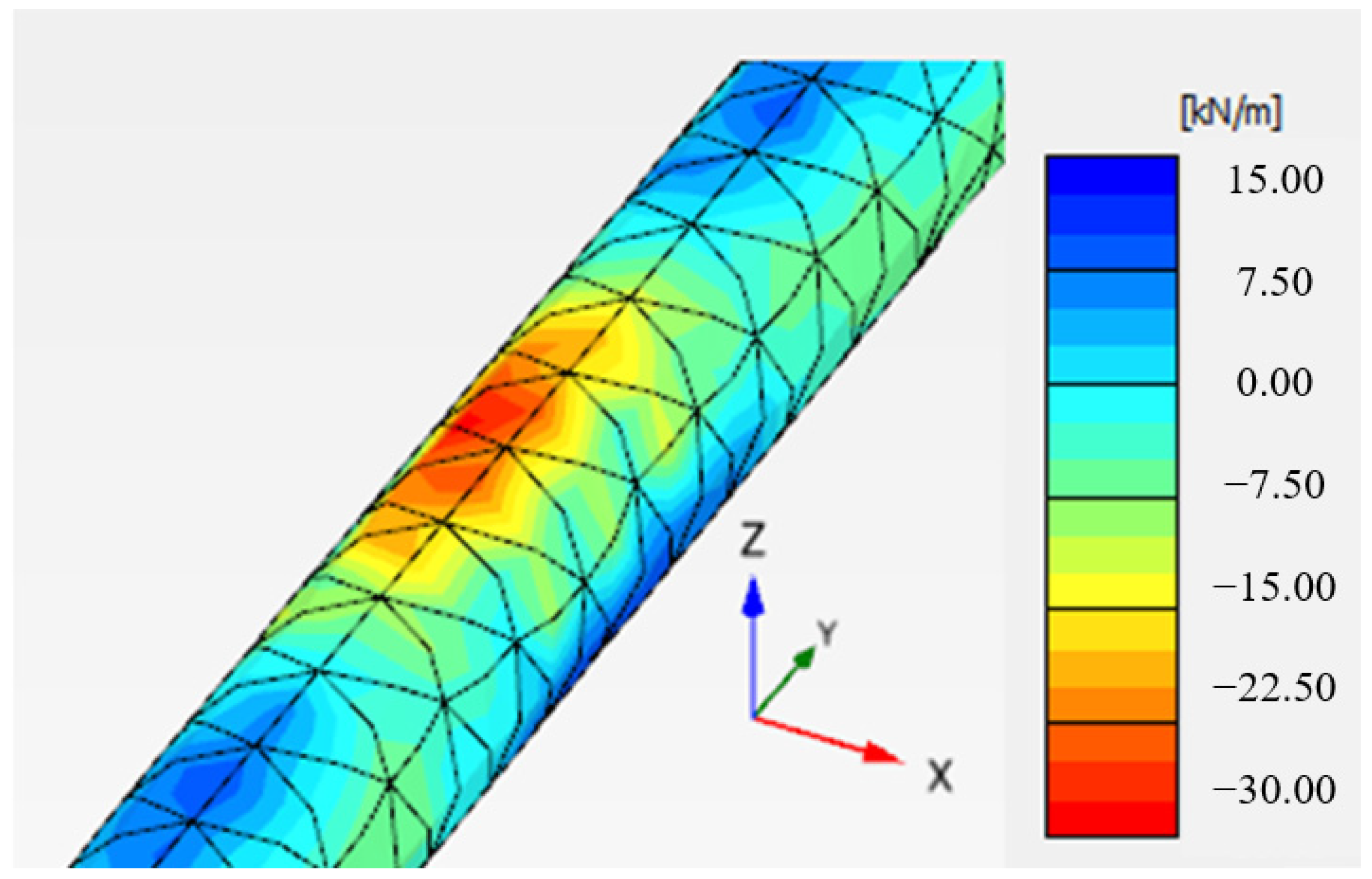
| Specific Requirements | Unit | Specification Limits | Test Results |
|---|---|---|---|
| Outer Diameter | mm | ------- | 1413 |
| Wall Thickness | mm | ------- | 29 |
| Initial Specific Stiffness (at 5% deflection) | N/m2 | 10,000 | 10,000 |
| Nominal Inner Diameter | mm | Ø 1400 ± 14 | 1384 |
| Standards | ASTM D2487 [19] | AASHTO M145 [20] | Iraqi S | ASTM D3839 [18] |
|---|---|---|---|---|
| Soil Classification | SP (Poorly graded sand with gravel) | A-1-b | Class C | Soil stiffness class SC2 |
| Loading Case | Vehicle Type | Description of Vehicle | Position of Vehicle | Total Weight by Balance (Ton) | Load on Pipe According to Iraqi Method (kN) |
|---|---|---|---|---|---|
| 1 | Small Shovel | 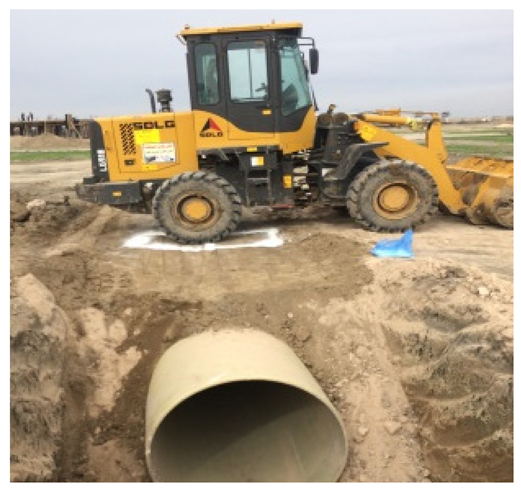 |  | 9.600 | 9.6 × 0.62 × 10 = 59.52 |
| 2 | Large Shovel | 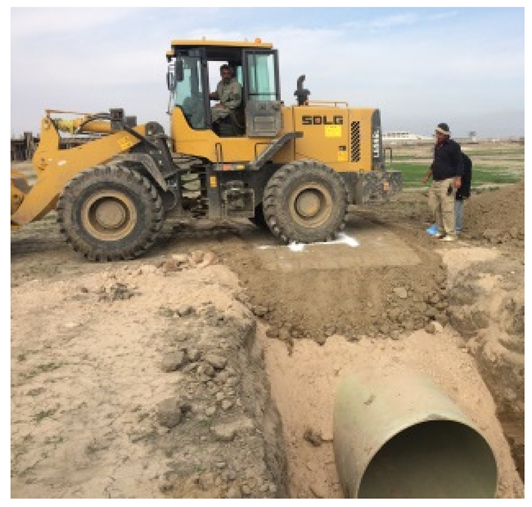 | 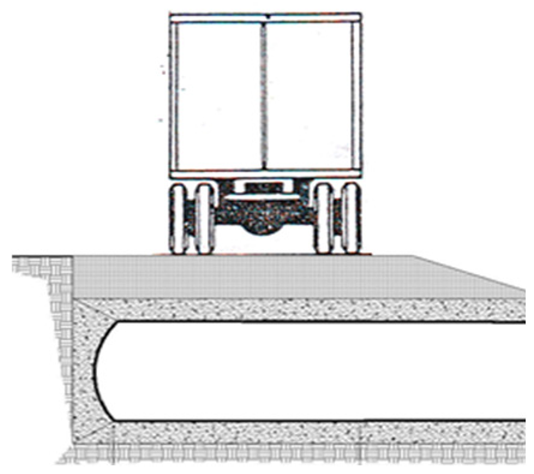 | 17.400 | 17.4 × 0.62 × 10 = 107.88 |
| 3 | Truck Type 3 |  | 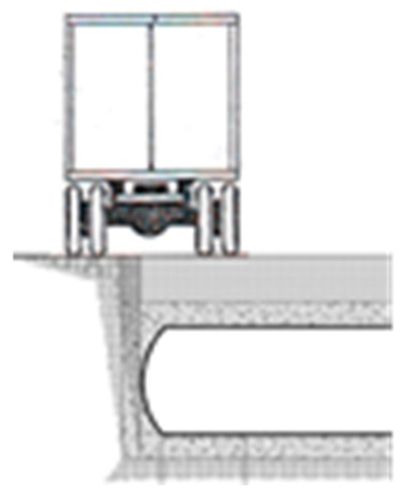 | 33.550 | 33.55 × 0.74 × 10/2 = 124.2 |
| 4 | Truck Type 2 |  | 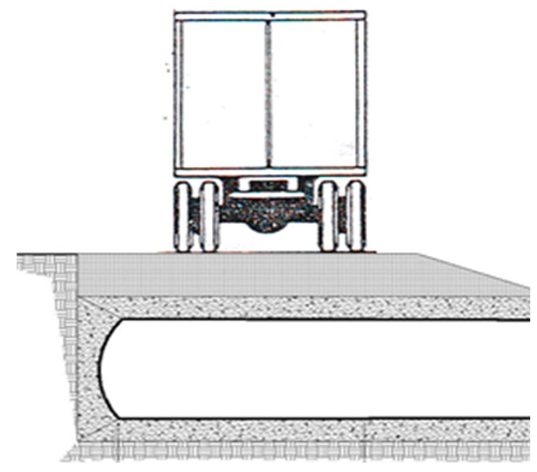 | 20.700 | 20.7 × 0.65 × 10 = 134.55 |
| 5 | Truck Type 3 | 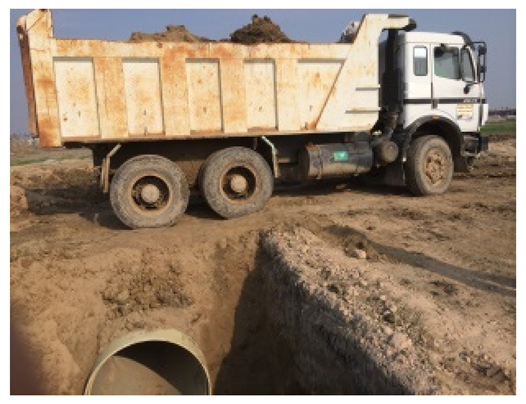 |  | 33.550 | 33.55 × 0.74 × 10 = 248.5 |
| Parameters | Backfill Soil | Gravely Sand Soil | Bedding Soil | Native Soil |
|---|---|---|---|---|
| Model type | Hardening soil | Hardening soil | Hardening soil | Hardening soil |
| Unit weight (KN/m3) | 19 | 20 | 20 | 17 |
| E50ref (Mpa) | 21.5 | 107.8 | 143 | 10.7 |
| Eoedref (Mpa) | 17.25 | 86.25 | 115 | 8.6 |
| Eurref (Mpa) | 64 | 269.8 | 301 | 32 |
| Properties | Sand | Soft Clay |
|---|---|---|
| Model type | Mohr | Hardening |
| Drainage condition | Drained | Undrained |
| Unit weight (KN/m3) | 19.00 | 16.00 |
| Sat. unit weight (KN/m3) | 20.00 | 17.50 |
| Void Ratio | 0.50 | 1.10 |
| Compression index (Cc) | - | 0.2 |
| Swelling index (Cs) | - | 0.05 |
| Elastic modulus, E (KPa) | 50,000 | - |
| Cohesion (C) | 3 | 8 |
| Angle of friction (ϕ) | 420 | 270 |
| Poisson Ratio (ν) | 0.3 | 0.3 |
| Case | Bedding Depth, d (m) | Backfill Depth, H (m) | Pipe Diameter, D (m) | Pipe Thickness, t (mm) | Pipe Material |
|---|---|---|---|---|---|
| 1 | 0.50 | 0.50 | 1.00 | 15.00 | GRP |
| 2 | 0.50 | 1.00 | 1.00 | 15.00 | GRP |
| 3 | 0.50 | 1.50 | 1.00 | 15.00 | GRP |
| 4 | 0.50 | 2.00 | 1.00 | 15.00 | GRP |
| 5 | 1.00 | 0.50 | 1.00 | 15.00 | GRP |
| 6 | 1.00 | 1.00 | 1.00 | 15.00 | GRP |
| 7 | 1.00 | 1.50 | 1.00 | 15.00 | GRP |
| 8 | 1.00 | 2.00 | 1.00 | 15.00 | GRP |
| 9 | 1.50 | 0.50 | 1.00 | 15.00 | GRP |
| 10 | 1.50 | 1.00 | 1.00 | 15.00 | GRP |
| 11 | 1.50 | 1.50 | 1.00 | 15.00 | GRP |
| 12 | 1.50 | 2.00 | 1.00 | 15.00 | GRP |
| 13 | 2.00 | 0.50 | 1.00 | 15.00 | GRP |
| 14 | 2.00 | 1.00 | 1.00 | 15.00 | GRP |
| 15 | 2.00 | 1.50 | 1.00 | 15.00 | GRP |
| 16 | 2.00 | 2.00 | 1.00 | 15.00 | GRP |
| 17 | 1.00 | 1.00 | 1.50 | 15.00 | GRP |
| 18 | 1.00 | 1.00 | 2.00 | 15.00 | GRP |
| 19 | 1.00 | 1.00 | 2.50 | 15.00 | GRP |
| 20 | 1.00 | 1.00 | 1.50 | 20.00 | GRP |
| 21 | 1.00 | 1.00 | 1.50 | 25.00 | GRP |
| 22 | 1.00 | 1.00 | 1.50 | 30.00 | GRP |
| 23 | 1.00 | 1.00 | 1.50 | 35.00 | GRP |
| 24 | 1.00 | 1.00 | 1.50 | 15.00 | Steel |
| 25 | 1.00 | 1.00 | 1.50 | 20.00 | Steel |
| 26 | 1.00 | 1.00 | 1.50 | 25.00 | Steel |
| 27 | 1.00 | 1.00 | 1.50 | 30.00 | Steel |
| Soil | Backfill | Bedding |
|---|---|---|
| Model type | Mohr | Mohr |
| Drainage condition | Drained | Drained |
| Unit weight (KN/m3) | 19.00 | 19.00 |
| Sat. unit weight (KN/m3) | 20.00 | 20.00 |
| Void Ratio | 0.50 | 0.50 |
| Compression index (Cc) | - | - |
| Swelling index (Cs) | - | - |
| Elastic modulus, E (KPa) | 50,000 | 200,000 |
| Cohesion (C) | 1 | 1 |
| Angle of friction (ϕ) | 420 | 500 |
| Poisson Ratio (ν) | 0.3 | 0.3 |
Disclaimer/Publisher’s Note: The statements, opinions and data contained in all publications are solely those of the individual author(s) and contributor(s) and not of MDPI and/or the editor(s). MDPI and/or the editor(s) disclaim responsibility for any injury to people or property resulting from any ideas, methods, instructions or products referred to in the content. |
© 2024 by the authors. Licensee MDPI, Basel, Switzerland. This article is an open access article distributed under the terms and conditions of the Creative Commons Attribution (CC BY) license (https://creativecommons.org/licenses/by/4.0/).
Share and Cite
Said, A.I.; Hussien, Y.J.; Mohammed, M.H.; Allawi, A.A.; Ibrahim, T.H.; El-Zohairy, A.; Abdelbaset, A.M. Experimental and FE Investigations of Backfill Cover on Large-Diameter GRP Pipes. CivilEng 2024, 5, 646-672. https://doi.org/10.3390/civileng5030035
Said AI, Hussien YJ, Mohammed MH, Allawi AA, Ibrahim TH, El-Zohairy A, Abdelbaset AM. Experimental and FE Investigations of Backfill Cover on Large-Diameter GRP Pipes. CivilEng. 2024; 5(3):646-672. https://doi.org/10.3390/civileng5030035
Chicago/Turabian StyleSaid, AbdulMuttalib I., Yahya Jabbar Hussien, Mohammed Hazim Mohammed, Abbas A. Allawi, Teghreed H. Ibrahim, Ayman El-Zohairy, and Ahmed M. Abdelbaset. 2024. "Experimental and FE Investigations of Backfill Cover on Large-Diameter GRP Pipes" CivilEng 5, no. 3: 646-672. https://doi.org/10.3390/civileng5030035
APA StyleSaid, A. I., Hussien, Y. J., Mohammed, M. H., Allawi, A. A., Ibrahim, T. H., El-Zohairy, A., & Abdelbaset, A. M. (2024). Experimental and FE Investigations of Backfill Cover on Large-Diameter GRP Pipes. CivilEng, 5(3), 646-672. https://doi.org/10.3390/civileng5030035










